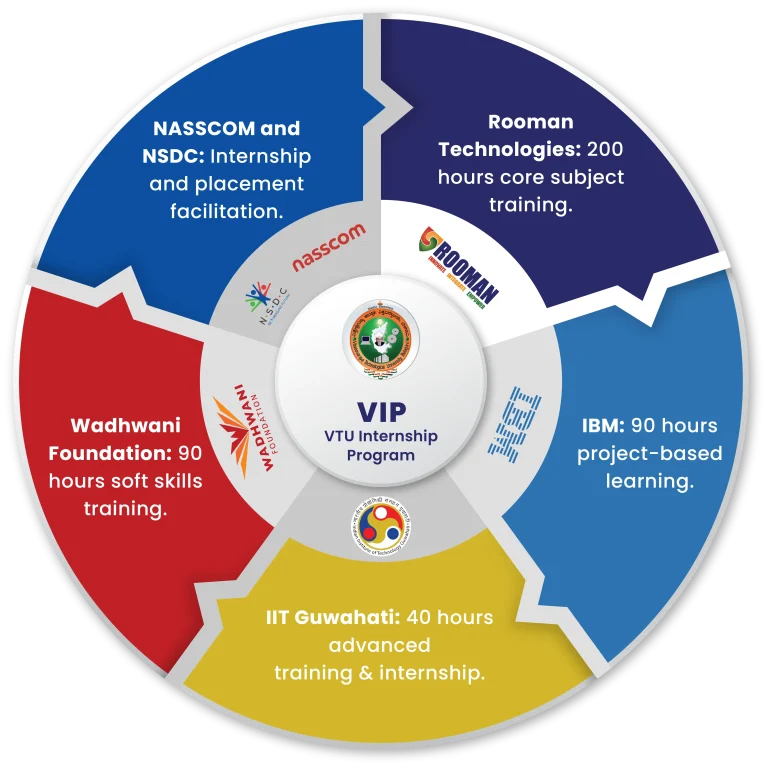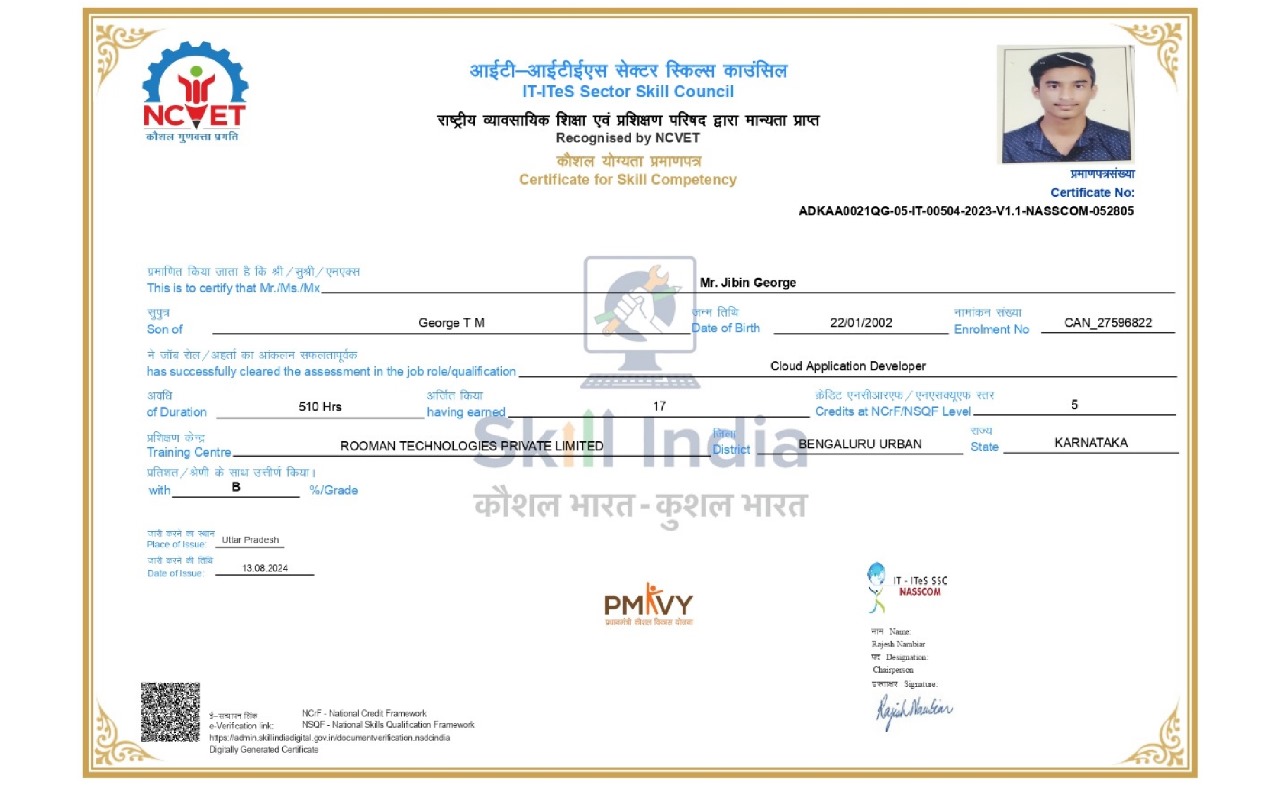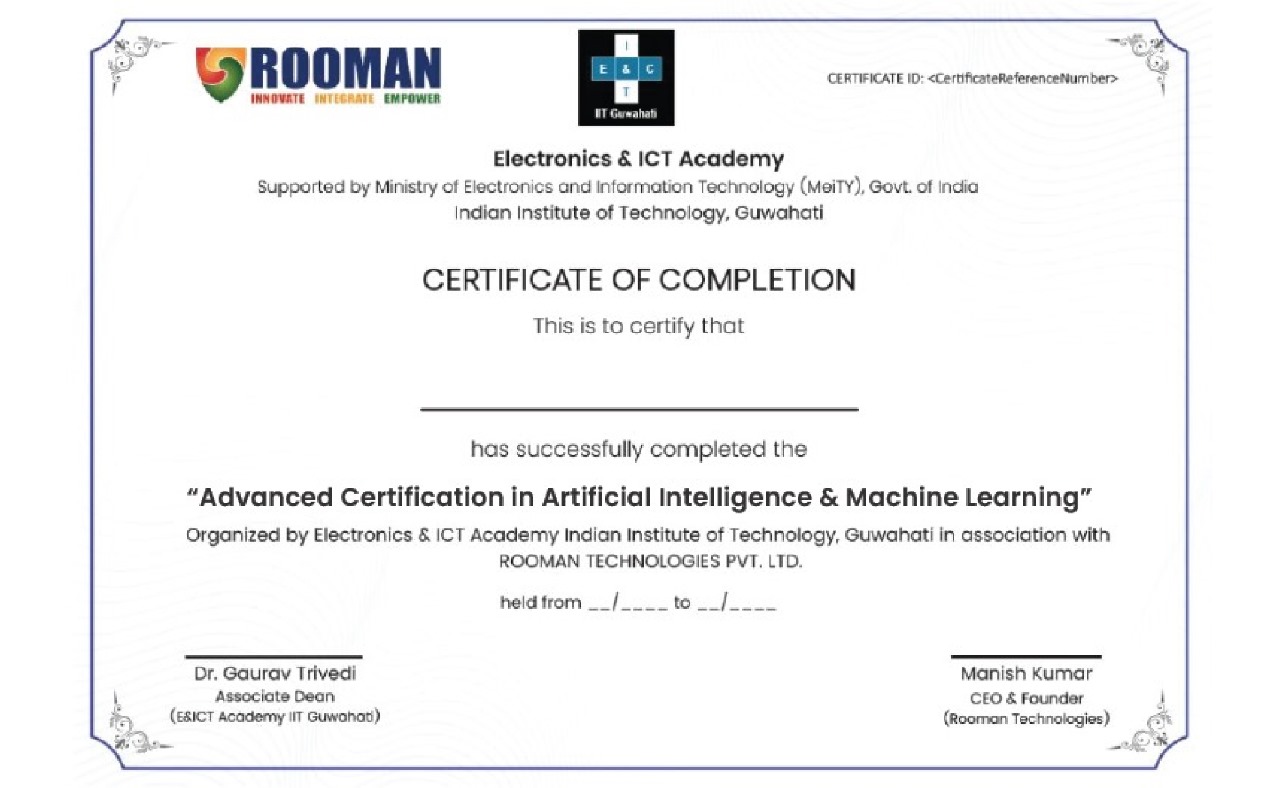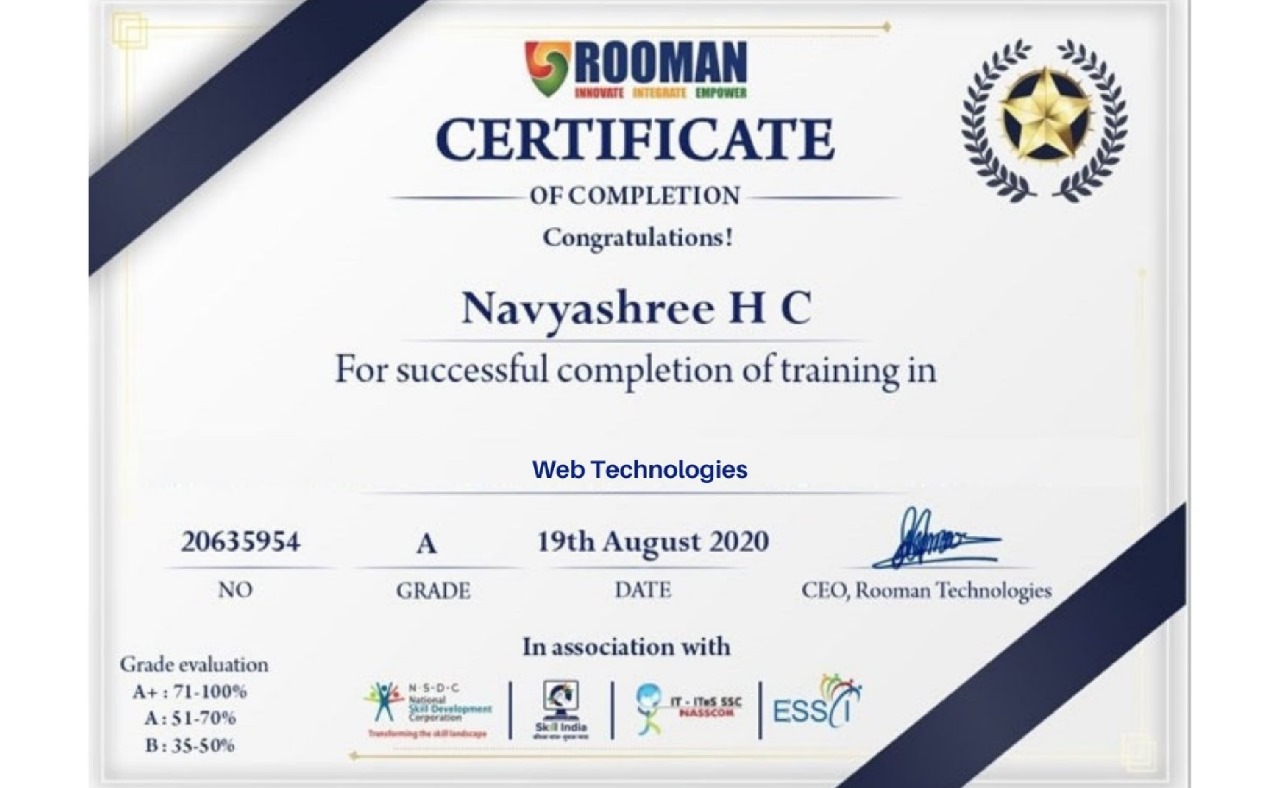.png)
.png)
About Internship Program
Skillhub is an innovative initiative designed to bridge the gap between academic education and industry requirements. In collaboration with Visvesvaraya Technological University (VTU) and Rooman Technologies, Skillhub offers a unique and comprehensive internship training program specifically tailored for 7th-semester students across VTU’s network of affiliated engineering colleges and technical institutions.
Why Internship Program is Your Path to Success
In the rapidly evolving job market, having the right set of skills is more crucial than ever. Skillhub is designed to equip you with the industry-relevant knowledge and hands-on experience necessary to excel in your chosen career. This program is a rare opportunity where leading industry giants and esteemed academic institutions have come together to create a pathway that transforms students into highly employable graduates.
Program Highlights: Unparalleled Industry-Driven Training

As a leader in IT certifications and future skills, Rooman Technologies will provide 200 hours of core subject training. This intensive training is led by industry experts who bring real-world insights and practical knowledge to the classroom. The focus is on ensuring that you not only grasp theoretical concepts but also learn how to apply them effectively in professional settings.
IBM, a global leader in technology and innovation, will offer 90 hours of project-based learning. This hands-on approach will allow you to work on real projects, giving you the opportunity to apply your skills in a practical environment. Upon completion, you will receive a certificate of project completion from IBM, a credential that will significantly enhance your resume.
One of India’s premier institutions, IIT Guwahati, will provide 40 hours of advanced training on cutting-edge topics. In addition to this, IIT Guwahati will offer a one-month research internship at their campus to 2-3 selected candidates from each college. This prestigious opportunity will allow you to engage in high-level research and development, further honing your skills and expanding your academic and professional horizons.
Understanding the importance of soft skills in today’s job market, the Wadhwani Foundation will offer 90 hours of soft skills training. This course is designed to improve your communication, teamwork, leadership, and problem-solving abilities, making you a well-rounded candidate who is ready to thrive in any work environment.
In a bid to ensure that your transition from academia to industry is smooth, NASSCOM and NSDC will actively engage with industries to facilitate internships and placement opportunities. This direct connection with employers will give you a significant advantage in securing a position in the competitive job market.
What Makes Internship Program Unique?
Skillhub is not just another internship program; it is a comprehensive, industry-led training initiative that stands out due to its collaborative nature:
This program is a one-of-a-kind collaboration between leading industry players like IBM, Rooman Technologies, Wadhwani Foundation, and prestigious academic institutions like IIT Guwahati. Together, they are committed to providing you with the skills needed to be highly employable.
The curriculum is carefully crafted to ensure a balance between technical skills and soft skills. The combination of core subject training, project-based learning, advanced research opportunities, and soft skill enhancement ensures that you are prepared to meet the demands of the modern workplace.
Upon successful completion of the Skillhub program, you will receive multiple prestigious certifications, adding significant value to your professional profile:
-
- Course Completion Certificate from Rooman Technologies:Validating your comprehensive training in core subjects.
- Internship and Project Certificate from IBM:A testament to your hands-on experience and project work with a global tech leader.
- PMKVY Certificate from NASSCOM/NSDC:Recognizing your skills in line with the national standards set by the Pradhan Mantri Kaushal Vikas Yojana (PMKVY).
- Advanced Certificate from IIT Guwahati:Acknowledging your advanced training and academic excellence from one of India’s top engineering institutes.
- Soft Skills and Entrepreneurship Certificate from Wadhwani Foundation: Demonstrating your proficiency in essential soft skills and entrepreneurial capabilities.
Program Structure
Courses Offered






Certification





Real-Time Projects
Design an e-commerce platform that integrates a React.js front-end with a Node.js and Express.js back-end. Discuss the challenges and solutions for synchronizing data between the front-end and back-end, ensuring real-time updates, and handling user authentication and payment processing.
Implement a serverless architecture using IBM Cloud Functions to process and analyze real-time data from IoT devices. Explore how serverless functions can be used to handle variable workloads and the benefits and limitations of this approach.
Develop a RESTful API for a task management application and integrate it with a front-end built using React.js. Discuss how to design the API endpoints, manage state in React.js, and ensure secure communication between the client and server.
Migrate a legacy application’s database from MySQL to MongoDB and implement a hybrid approach to handle existing and new data. Discuss the challenges of data migration, managing data consistency, and the advantages of using MongoDB over MySQL.
Implement a Continuous Integration and Continuous Deployment (CI/CD) pipeline for a web application using tools like Jenkins or GitHub Actions. Explain how to automate the build, test, and deployment processes, and discuss strategies for handling deployment rollbacks.
Deploy an application and use performance monitoring tools like New Relic or Datadog to track its performance. Describe how to set up monitoring, analyze performance data, and implement optimizations based on the insights gained.
Develop a plan to implement inclusive and environmentally sustainable practices in a technology company. Discuss strategies for promoting diversity, reducing the company’s carbon footprint, and measuring the impact of these practices.
Design a scalable cloud-based application using AWS or Azure services. Explore how to leverage cloud resources to handle varying loads, manage costs, and ensure high availability and disaster recovery.
Build a web application that requires real-time synchronization between the front-end and back-end. Discuss how to implement WebSockets or similar technologies to achieve real-time updates and manage state consistency across different components.
Develop a security plan for a RESTful API used in a financial application. Discuss the implementation of authentication and authorization mechanisms, rate limiting, and data encryption to protect the API from potential security threats.
Cloud platforms offer scalable web hosting solutions that allow businesses to deploy and manage websites and web applications with dynamic traffic demands. Using services such as auto-scaling and load balancing, cloud infrastructure adjusts resources automatically based on current traffic loads, ensuring optimal performance and availability.
Cloud-based backup and recovery solutions provide a secure and scalable way to protect critical data. By storing backups in the cloud, organizations ensure that their data is safe from hardware failures, natural disasters, or accidental deletions. Automated backup schedules and easy data restoration options facilitate rapid recovery and minimize downtime.
Cloud services enable organizations to analyze large volumes of data efficiently using distributed computing frameworks such as Apache Hadoop and Apache Spark. Cloud platforms offer scalable storage and processing power, allowing businesses to perform complex analytics and gain insights from big data without managing physical infrastructure.
Cloud-based disaster recovery solutions provide businesses with the ability to quickly recover from disruptive events. By leveraging cloud resources, organizations can implement fail over and recovery processes that minimize downtime and data loss, ensuring continuity of operations during emergencies.
Cloud platforms offer flexible environments for development and testing, allowing developers to provision, configure, and scale resources as needed. This enables rapid experimentation and testing of new features or applications, without the constraints of physical hardware or infrastructure limitations.
Cloud-based CDNs enhance the delivery of web content by caching and distributing it across multiple edge locations globally. This reduces latency and improves load times for end-users by serving content from servers that are geographically closer to them, ensuring a better user experience.
Cloud computing supports the development and management of IoT applications by providing scalable infrastructure for processing and analyzing data from connected devices. Cloud platforms offer tools and services for data ingestion, real-time analytics, and integration with other applications, facilitating effective IoT solutions.
Cloud services provide robust platforms for developing and deploying AI and machine learning models. Organizations can leverage pre-built AI services, train custom models, and scale computational resources as needed, enabling advanced analytics and intelligent application features without investing in on-premises hardware.
Cloud-based CRM systems offer comprehensive tools for managing customer interactions, sales, marketing, and support. Accessible from anywhere with an internet connection, these solutions provide businesses with features for tracking customer data, automating sales processes, and improving customer service.
Cloud-based virtual desktop infrastructure (VDI) provides employees with secure remote access to their desktop environments. This use case supports flexible work arrangements by enabling users to access their workstations, applications, and data from various locations, enhancing productivity and collaboration.
Implement advanced AI-driven anomaly detection algorithms to identify atypical patterns in financial transaction data. This includes employing machine learning models such as Isolation Forest or Autoencoders to detect potential fraudulent activities or errors, enhancing data integrity and security.
Utilize sophisticated AI techniques, including supervised learning algorithms and clustering methods, to clean and validate customer data within CRM systems. Develop algorithms to detect and resolve inaccuracies, duplicate entries, and incomplete records, thereby improving the overall reliability of customer profiles.
Apply Natural Language Processing (NLP) and machine learning techniques to automate the data cleansing process for electronic health records (EHRs). This involves standardizing medical terminology, correcting typographical errors, and ensuring consistency across patient records using AI models trained on healthcare-specific data.
Integrate AI models to refine the quality of sensor data used in predictive maintenance systems for industrial equipment. Employ data validation techniques and machine learning algorithms to clean sensor data, ensuring accurate predictions of equipment failures and optimizing maintenance schedules.
Implement AI-driven tools to identify and address biases in training datasets for machine learning models. Utilize techniques such as Fairness Constraints and Adversarial Debiasing to detect and correct biased data distributions, ensuring equitable outcomes in AI model predictions.
Deploy AI algorithms to monitor and validate the quality of real-time streaming data from IoT sensors or financial markets. Use techniques such as stream data validation and anomaly detection to perform real-time accuracy checks, ensuring consistency and completeness of the streaming data.
Leverage AI to enhance data integration quality when consolidating data from diverse sources. Implement data matching and merging algorithms, such as entity resolution and similarity joins, to ensure data accuracy and consistency across integrated datasets for analytics.
Utilize AI to automate the monitoring of data quality within cloud-based data warehouses. Develop models to continuously assess data quality metrics, detect anomalies, and generate alerts for any integrity issues, ensuring high standards of data governance.
Apply advanced NLP techniques to improve the quality of textual data used in text analytics applications. Use algorithms for text normalization, entity recognition, and sentiment analysis to clean and validate data from sources such as customer reviews and social media.
Implement AI models to validate and standardize data across supply chain management systems. Employ machine learning techniques to ensure data accuracy in inventory records, order processing, and supplier information, facilitating consistent and reliable supply chain operations.
Utilize IBM Watson's advanced AI capabilities to analyze customer interactions across various channels (e.g., emails, chat, social media). Implement Watson's AI services to extract deep insights, such as customer intent, sentiment trends, and emerging issues. Use these insights to drive personalized marketing strategies and improve customer engagement through targeted interventions.
Design and implement a real-time data collection and processing pipeline for social media data. Use tools like Apache Kafka and Apache Flink to capture, process, and analyze data streams from platforms like Twitter or Facebook. Apply sentiment analysis and trend detection algorithms to gain insights into public opinion and emerging trends.
Conduct advanced exploratory data analysis on large-scale genomic datasets to identify genetic variations associated with diseases. Use techniques like Principal Component Analysis (PCA) and t- Distributed Stochastic Neighbor Embedding (t-SNE) for dimensionality reduction and visualization. Apply statistical tests and correlation analysis to uncover significant genetic markers and patterns.
Apply advanced clustering techniques (e.g., DBSCAN, Hierarchical Clustering) and dimensionality reduction methods (e.g., t-SNE) to analyze and visualize customer journeys across multiple touchpoints. Identify distinct customer segments and behavioral patterns to enhance customer experience and optimize marketing strategies.
Implement transformer-based models like BERT (Bidirectional Encoder Representations from Transformers) or GPT (Generative Pre-trained Transformer) for advanced natural language understanding tasks. Apply these models to complex NLP applications such as question answering, text summarization, and document comprehension, achieving state-of-the-art performance in language processing.
Use Bayesian optimization techniques to automate model selection and hyperparameter tuning for machine learning models. Implement tools like Hyperopt or Optuna to explore the hyperparameter space efficiently and select the best-performing models based on cross-validated performance metrics. This approach enhances model accuracy and optimizes computational resources.
Develop an ensemble regression model combining techniques like Gradient Boosting, Random Forests, and XGBoost for accurate real estate valuation. Integrate various data sources, including historical property sales, economic indicators, and neighborhood features, to enhance prediction accuracy and provide detailed property valuations.
Employ deep learning-based clustering techniques (e.g., Deep Embedded Clustering) to segment market data. Integrate neural networks with clustering algorithms to uncover hidden patterns and customer segments in complex datasets, enabling more targeted marketing and personalized product offerings
Implement a real-time language translation system using advanced neural machine translation models like Transformer-based architectures. Optimize the model for low-latency and high-quality translations in multiple languages, supporting applications in international communication and travel.
Develop automated model ensemble systems that combine multiple machine learning models to improve prediction accuracy. Implement techniques like stacking, blending, and bagging with automated pipelines to select and optimize the best-performing models based on validation results.
A development team is facing issues with long deployment times and frequent production issues. The goal is to introduce DevOps practices to enhance deployment efficiency and reliability. This involves implementing practices such as continuous integration, continuous deployment, infrastructure as code, and automated testing.
An organization needs to establish a CI/CD pipeline to automate their deployment process. Essential components include version control systems, build servers, automated testing tools, and deployment tools. Each component must be configured to work seamlessly together to automate the build, test, and deployment phases.
Managing infrastructure for a microservices application requires consistent and repeatable deployments. Tools like Ansible and Terraform can automate infrastructure provisioning and configuration. The goal is to ensure that the infrastructure setup is reliable and scalable.
A company wants to implement proactive monitoring to prevent downtime. This involves using monitoring tools to track system performance, detect anomalies, and set up alerts for potential issues before they impact availability.
A team is struggling with security management across various environments. Implementing DevSecOps practices involves automating security processes, integrating security tools into the CI/CD pipeline, and ensuring that security measures are consistently applied across all environments.
An organization wants to adopt a multi-cloud strategy using containers. Docker and Kubernetes can be utilized to manage containerized applications across different cloud environments, providing flexibility and scalability.
Managing configurations for multiple environments can be complex. Using Ansible for automation can simplify this process by providing consistent configuration management and ensuring that configurations are applied uniformly across different environments.
A team is using various collaboration tools, and integrating them is proving challenging. Streamlining the usage of these tools involves selecting the right integrations and ensuring that the tools work together efficiently to enhance productivity and reduce complexity.
Evaluating the effectiveness of automation strategies involves tracking performance metrics, analyzing the impact of automation on deployment speed and quality, and identifying areas for improvement.
Adopting a cloud-native approach involves designing applications that leverage cloud services and deploying them using container orchestration tools like Kubernetes. IBM Cloud can provide the necessary infrastructure and services for building and managing cloud-native application.
